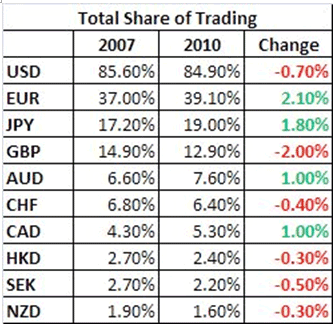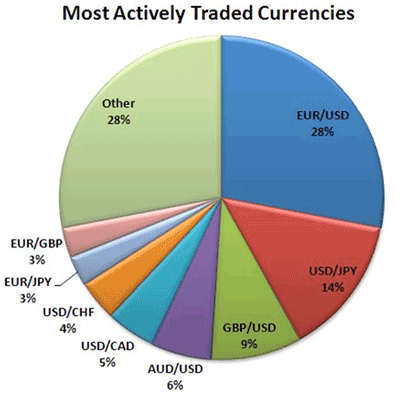This morning, the Bank of International Settlements (BIS) released its triennial FX survey, which is basically the market’s benchmark for forex volume and turnover. To no one’s surprise, volume has surged over the past three years. Between April 2007 and April 2010, global foreign exchange market increased by 20% from $3.3 trillion to $4.0 trillion, which is now the golden number for forex volume.
Reading between the lines, we can tell that a large part of the increase in volume is due to the trading activities of retail traders! (Yes, we are making a big difference!) According to the BIS report, 48% of the growth was in spot transactions, which represents 37% of the total turnover (or total FX flow). Although swaps became more popular to trade, all other related foreign exchange instruments saw only a 7% increase in volume. The report also says that “the higher global foreign exchange market turnover is associated with the increased trading activity of ‘other financial institutions’” (think retail forex brokers). Turnover in this category rose 42%, and for the first time ever, reporting dealers (banks) did more transactions with “other financial institutions” than with other banks.
Having just come back from Singapore, where shelves and shelves were filled with forex trading books, I am in no way surprised that the BIS has confirmed the popularity of forex trading.
The foreign exchange market also became more global with cross-border transactions representing 65% of trading activity in April 2010, while local transactions account for 35%.
US Dollar Becoming Less Important
Back in 2001, the US dollar was involved in 90% of all currency transactions, and as of April 2010, this fell to 84.9%. The decline in trading of dollars has benefited the euro, which gained two percentage points in market share since the last survey and accounts for 39% of all transactions. “The Japanese yen also increased its market share by two percentage points to 19%, a recovery relative to the 2007 survey but still below its peak of 23.5% reached in 2001. The pound sterling gave up most of its post-euro gains, with its share returning to the immediate post-euro level of around 13%. Trading in the Swiss franc also declined marginally to 6.4% from 6.8% in April 2007. The Australian and Canadian dollars both increased their share by around one percentage point, to 7.6% and 5.3%, respectively.”
“The percentage share of the US dollar has continued its slow decline witnessed since the April 2001 survey, while the euro and the Japanese yen gained relative to April 2007. Among the ten most actively traded currencies, the Australian and Canadian dollars both increased market share, while the pound sterling and the Swiss franc lost ground. The market share of emerging market currencies increased, with the biggest gains for the Turkish lira and the Korean won.”
Of the major currency pairs, trading of EUR/USD and USD/JPY have increased, while trading of the GBP/USD has decreased.
The UK is still the largest trading center for forex, but the relative ranking of foreign exchange trading centers has changed slightly from the previous survey. The United Kingdom continued to be the most active location, with a share of 46% of worldwide trading, followed by the United States, with a share of 24%, which is slightly down from 2007. Outside these two centers, trading took place primarily in France (7%) and Japan (3%), both slightly down from 2007; and Singapore (3%) and Switzerland (3%), both slightly up. Turnover in Germany almost halved to less than 2% in April 2010 compared with 2007. Banks located in the United Kingdom accounted for 36.7% of all foreign exchange market turnover, versus 34.6% in 2007, followed by the United States (18%), Japan (6%), Singapore (5%), Switzerland (5%), Hong Kong SAR (5%), and Australia (4%).
Lower Forex Margin Should Temper Volume Increases in the Future
However, the pace of growth will most likely be moderated by the reduction in leverage announced in the US and Japan. Last month, Japan reduced leverage to 50:1 and plans to bring this down even further to 25:1 next year. US regulators announced earlier this week that leverage would be capped at 50:1 for major currencies and 20:1 for all other currencies. This will go into effect on October 18. Lower leverage will make forex trading less attractive to some participants, but 50:1 is still very generous leverage by all counts, so it will not be catastrophic for the retail forex industry. We should still see retail trading contribute positively to forex volume, but probably not by the double-digit levels seen in past years.
By Kathy Lien, currency analyst, KathyLien.com






















